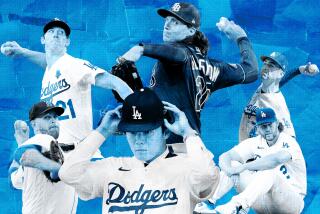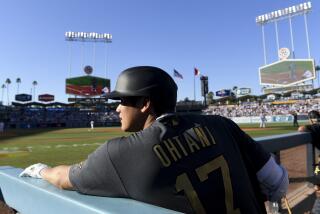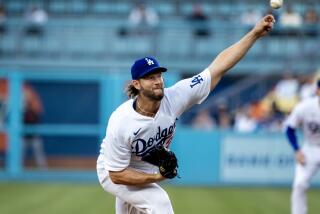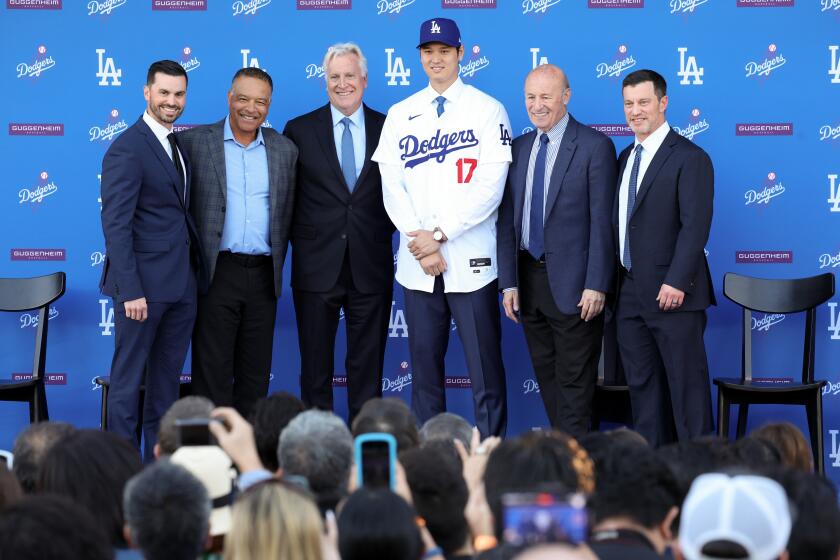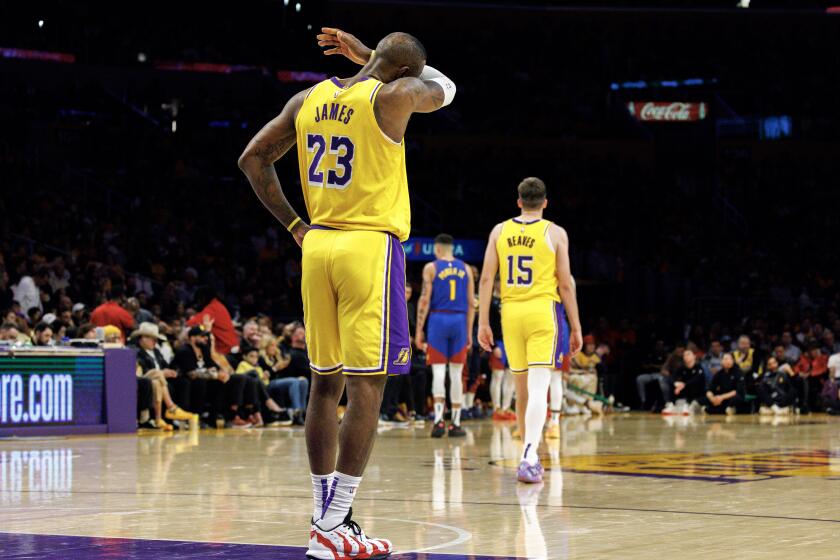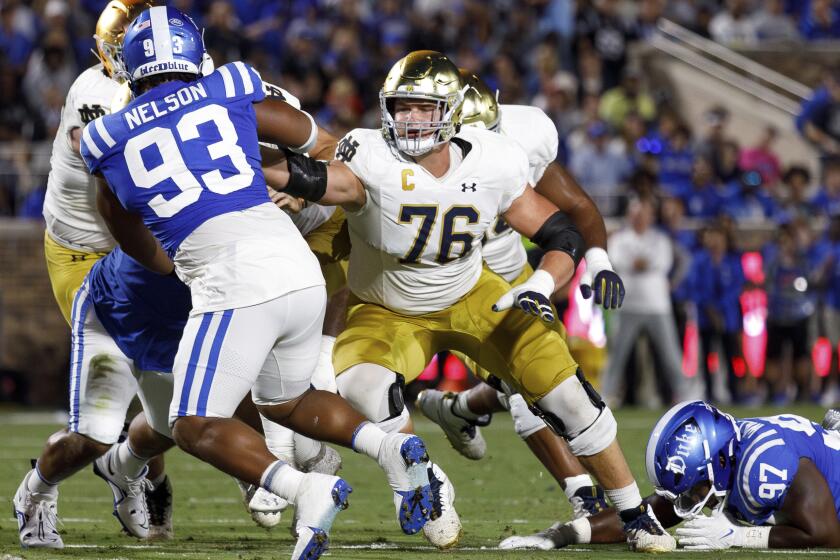Column: Note to Dodgers: It’s OK to trade prospects to give your team a chance to win it all
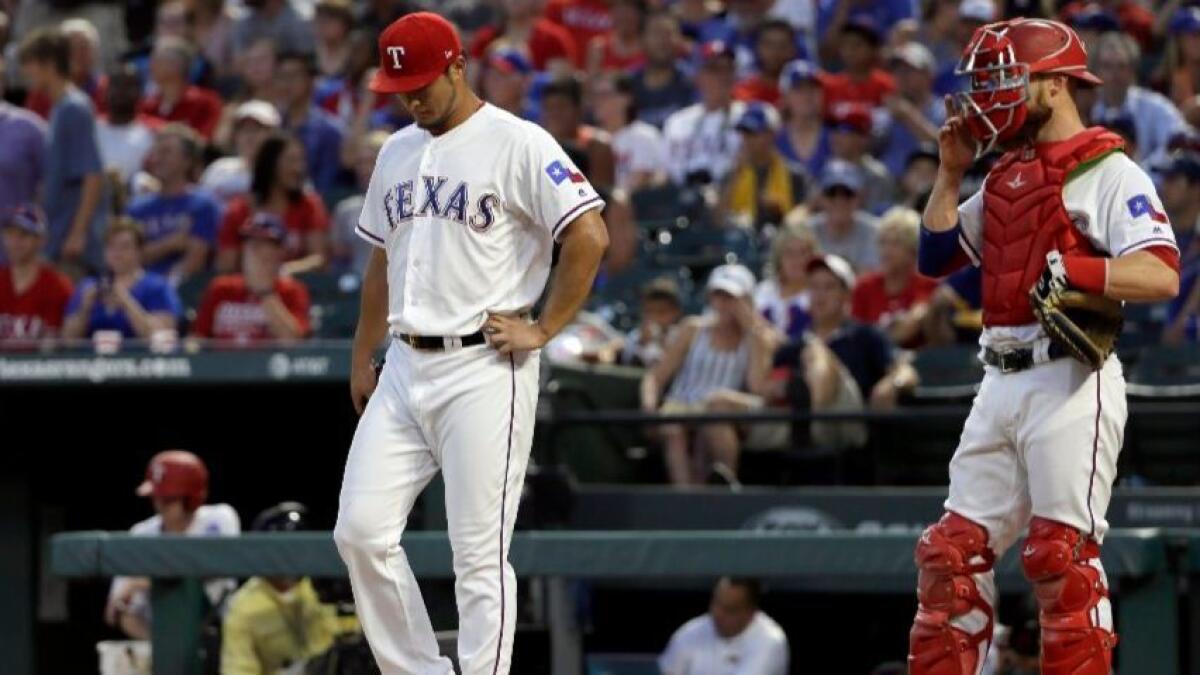
In this season of the home run, Dee Gordon had not hit one. Not until Wednesday, that is, when he took Yu Darvish deep.
For Darvish, the darling of baseball’s trade deadline, this was the worst possible time to have the worst start of his career. He was the starting pitcher for the Texas Rangers on the night they gave up 22 runs. He gave up 10 of them, and we’re supposed to believe this is the guy the Dodgers need to get to their first World Series since 1988?
Take a deep breath. The Dodgers should not react with panic to Darvish getting hit hard in his last start, any more than they should react with panic to Clayton Kershaw getting hurt in his last start.
Kershaw’s injury prompted an immediate and predictable flurry of national columns on how the Dodgers’ front office would not pivot to Darvish as a panicked reaction to Kershaw’s injury, and how the Dodgers are too disciplined to blow up the “unstoppable force” and “machine” the player development pipeline has become by surrendering top prospects in an effort to win a championship this year.
“The Dodgers care about today … and tomorrow … and the rest of the championships they plan on winning,” Yahoo columnist Jeff Passan wrote.
That’s been the party line since Stan Kasten arrived as president in 2012, even more so since Andrew Friedman took over baseball operations two years later.
The Dodgers do look like an unstoppable force on the field this summer. Kasten and his Guggenheim Baseball bosses have provided unrivaled resources to Friedman, who has deployed them to develop the relentless depth that can make an injury even to Kershaw be more of a nuisance than a calamity.
The Dodgers were interested in Darvish before Kershaw got hurt. They are not the only organization planning on winning championships.
So far, though, they have not deviated from their strategy. The best chance to win the World Series, they believe, is to try to win the division every year and hope luck goes their way in the postseason, rather than to trade elite prospects to enhance their chance in any given year.

The Dodgers also have not gotten further in the postseason under Guggenheim’s ownership than they did under Frank McCourt’s ownership.
The Dodgers should be proud of their prospects, and of their success. The franchise boasts a record streak of five consecutive rookies of the year, from 1992-96: Eric Karros, Mike Piazza, Raul Mondesi, Hideo Nomo and Todd Hollandsworth.
Yet that era is not remembered as a golden one for the Dodgers. For all that young talent, the team never got to the World Series.
This front office is smart, and flush with resources and resourcefulness. To claim that the loss of one or two top prospects would damage the Dodgers’ ability to contend every year is an insult to Friedman and his staff.
The point of rebuilding and replenishing the minor league system — a Kasten promise on which the Dodgers have more than delivered — is to help the major league team win. It should not need to be said that the most effective way to do that sometimes is to trade players who might help the team tomorrow for a player who will help the team today.
No one is suggesting the Dodgers clear out every elite prospect this year. But the evolution of what colleague Andy McCullough calls the “prospect-industrial complex” has made household names out of players before they take a single at-bat or throw a single pitch in the major leagues.
That has given rise to this popular sentiment: The Dodgers cannot trade Alex Verdugo.
What?
Baseball America ranks Verdugo as the No. 35 prospect in baseball. He is 21. He gets on base every day. He rarely strikes out. He can run. He plays a mean center field. His minor league statistics suggest that he compares to Brett Butler, with a little more power and much better defense.

Verdugo could be a good major league player, a very good one if the power blossoms. But he could go bust too.
There are no Bryce Harpers or Kris Bryants at No. 35.
Some prospects need years to develop. Let’s skip back five years, then check the previous 15 years of No. 35.
There is Yonder Alonso, who made his first All-Star team this year, in his eighth major league season. There is Matt Moore, whose earned-run average is near 6.00 this year.
There are decent major leaguers (Randall Delgado, Gavin Floyd, Kaz Ishii, Brad Wilkerson), replacement-value major leaguers (Rob Bell, Deolis Guerra, Guillermo Quiroz) and a never-was major leaguer (the Dodgers’ Jonathan Figueroa).
Jeff Niemann and Zack Wheeler got hurt. So did Joel Zumaya, who injured his wrist playing a video game. Ryan Minor was supposed to replace Cal Ripken. Ben Petrick suffered from early-onset Parkinson’s disease.
If there is risk in trading prospects, there is risk in not trading prospects.
The Dodgers did not trade for David Price, Cole Hamels or Johnny Cueto two summers ago because they did not want to trade Corey Seager, Joc Pederson or Julio Urias.
The teams that traded for Price and Hamels did not get to the World Series. But the team that traded for Cueto did, and he threw a complete game in helping the Kansas City Royals win it. That’s one in three.
Seager is a foundational player. Pederson is a platoon player, at least the way the Dodgers use him. Urias underwent shoulder surgery this year and might never realize his potential. That’s one in three.
The Chicago Cubs traded their best prospect to get Jose Quintana this season. They traded their best prospect to get Aroldis Chapman last season, a deal one Dodgers official said would have been a disaster for the Cubs had they not won the World Series.
The Cubs made it to the World Series, for the first time since 1945, and that was enough to validate the trade.
The Cubs were running away with their division last summer, just as the Dodgers are doing this summer. As Cubs President Theo Epstein said when he made the trade for Chapman, “If not now, when?”
Epstein wears three rings.
The Dodgers’ urgency should be compounded by the injury to Kershaw. This is the second consecutive year he has suffered a back injury. He might return in top form this year, as he did last year.
But the recurrence raises the possibility the Dodgers might already have seen the best years of Kershaw, who turns 30 next year. Without Kershaw as an ace, a team built on pitching would have a pretty ordinary starting rotation, prospects and all.
Sandy Koufax rode into Cooperstown on the basis of a five-year run, in which he won three Cy Young awards and the Dodgers got to the World Series three times.
Kershaw has won three Cy Young awards too. He is performing at the Cooperstown level for the seventh consecutive season. It would be nice for him, and for Dodgers fans, if his employers put the greatest reasonable emphasis on winning a ring in 2017, not an eighth consecutive division title in 2020.
Follow Bill Shaikin on Twitter @BillShaikin
More to Read
Get our high school sports newsletter
Prep Rally is devoted to the SoCal high school sports experience, bringing you scores, stories and a behind-the-scenes look at what makes prep sports so popular.
You may occasionally receive promotional content from the Los Angeles Times.

